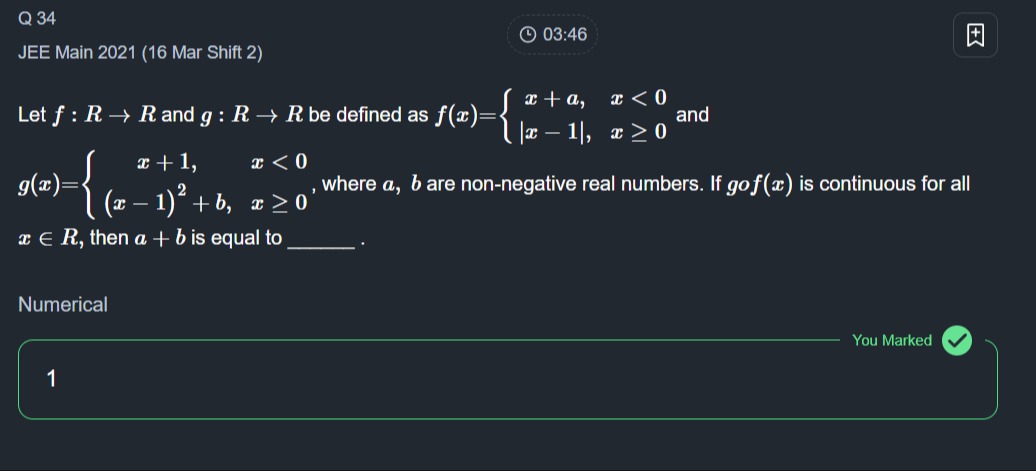Question
Question: Let $f: R \rightarrow R$ and $g: R \rightarrow R$ be defined as $f(x)=\begin{cases} x+a, & x<0 \\ |x...
Let f:R→R and g:R→R be defined as f(x)={x+a,∣x−1∣,x<0x≥0 and g(x)={x+1,(x−1)2+b,x<0x≥0, where a,b are non-negative real numbers. If gof(x) is continuous for all x∈R, then a+b is equal to ____.

1
2
3
4
1
Solution
The functions are defined as: f(x)={x+a,∣x−1∣,x<0x≥0 g(x)={x+1,(x−1)2+b,x<0x≥0 where a,b≥0.
First, let's analyze f(x) for x≥0: f(x)=∣x−1∣={1−x,x−1,0≤x<1x≥1 So, f(x) can be written as: f(x)=⎩⎨⎧x+a,1−x,x−1,x<00≤x<1x≥1
The composite function is gof(x)=g(f(x)). For gof(x) to be continuous, we need to check the continuity at points where f(x) might be discontinuous (x=0,x=1) and at points where f(x) makes the argument of g equal to the point of discontinuity of g (f(x)=0).
Let's find x such that f(x)=0:
- If x<0: x+a=0⟹x=−a. This is valid if −a<0, i.e., a>0.
- If 0≤x<1: 1−x=0⟹x=1. This is not in the interval [0,1).
- If x≥1: x−1=0⟹x=1. This is valid.
So, f(x)=0 at x=1 and possibly at x=−a (if a>0). The critical points for continuity of gof(x) are x=0,x=1, and x=−a (if a>0).
Case 1: a>0 The critical points are x=0,x=1,x=−a.
- Continuity at x=0:
- Left-hand limit: limx→0−gof(x). For x<0, f(x)=x+a. As x→0−, f(x)→a. Since a>0, f(x)>0. gof(x)=g(f(x))=g(x+a)=((x+a)−1)2+b. limx→0−gof(x)=(a−1)2+b.
- Right-hand limit: limx→0+gof(x). For x→0+, f(x)=∣x−1∣=1−x. As x→0+, f(x)→1. Since f(x)>0, gof(x)=g(f(x))=g(1−x)=((1−x)−1)2+b=(−x)2+b=x2+b. limx→0+gof(x)=02+b=b.
- Function value: f(0)=∣0−1∣=1. gof(0)=g(f(0))=g(1)=(1−1)2+b=b. For continuity at x=0: (a−1)2+b=b⟹(a−1)2=0⟹a=1. This is consistent with a>0. So, a=1.
Now a=1. The critical points are x=0,x=1,x=−1. f(x)=⎩⎨⎧x+1,1−x,x−1,x<00≤x<1x≥1
- Continuity at x=−1:
- Left-hand limit: limx→−1−gof(x). For x<−1, f(x)=x+1. So f(x)<0. gof(x)=g(f(x))=g(x+1)=(x+1)+1=x+2. limx→−1−gof(x)=−1+2=1.
- Right-hand limit: limx→−1+gof(x). For −1≤x<0, f(x)=x+1. So 0≤f(x)<1, which means f(x)≥0. gof(x)=g(f(x))=g(x+1)=((x+1)−1)2+b=x2+b. limx→−1+gof(x)=(−1)2+b=1+b.
- Function value: f(−1)=−1+1=0. gof(−1)=g(f(−1))=g(0)=0+1=1. For continuity at x=−1: 1=1+b⟹b=0. This is consistent with b≥0. So, b=0.
With a=1 and b=0, we have a+b=1. Let's verify continuity at x=1. f(x)=⎩⎨⎧x+1,1−x,x−1,x<00≤x<1x≥1, g(x)={x+1,(x−1)2,x<0x≥0
- Left-hand limit at x=1: limx→1−gof(x). For 0≤x<1, f(x)=1−x. As x→1−, f(x)→0+, so f(x)≥0. gof(x)=g(f(x))=g(1−x)=((1−x)−1)2=(−x)2=x2. limx→1−gof(x)=12=1.
- Right-hand limit at x=1: limx→1+gof(x). For x≥1, f(x)=x−1. As x→1+, f(x)→0+, so f(x)≥0. gof(x)=g(f(x))=g(x−1)=((x−1)−1)2=(x−2)2. limx→1+gof(x)=(1−2)2=1.
- Function value: f(1)=1−1=0. gof(1)=g(f(1))=g(0)=0+1=1. Continuity at x=1 is satisfied. Thus, a=1,b=0 is a valid solution, giving a+b=1.
Case 2: a=0 The critical points are x=0,x=1. f(x)=⎩⎨⎧x,1−x,x−1,x<00≤x<1x≥1
- Continuity at x=0:
- Left-hand limit: limx→0−gof(x). For x<0, f(x)=x. So f(x)<0. gof(x)=g(f(x))=g(x)=x+1. limx→0−gof(x)=0+1=1.
- Right-hand limit: limx→0+gof(x). For x→0+, f(x)=1−x→1. So f(x)>0. gof(x)=g(f(x))=g(1−x)=((1−x)−1)2+b=x2+b. limx→0+gof(x)=02+b=b.
- Function value: f(0)=∣0−1∣=1. gof(0)=g(f(0))=g(1)=(1−1)2+b=b. For continuity at x=0: 1=b. So, a=0,b=1.
Now let's check continuity at x=1 with a=0,b=1. f(x)=⎩⎨⎧x,1−x,x−1,x<00≤x<1x≥1, g(x)={x+1,(x−1)2+1,x<0x≥0
- Left-hand limit at x=1: limx→1−gof(x). For 0≤x<1, f(x)=1−x. As x→1−, f(x)→0+, so f(x)≥0. gof(x)=g(f(x))=g(1−x)=((1−x)−1)2+1=(−x)2+1=x2+1. limx→1−gof(x)=12+1=2.
- Right-hand limit at x=1: limx→1+gof(x). For x≥1, f(x)=x−1. As x→1+, f(x)→0+, so f(x)≥0. gof(x)=g(f(x))=g(x−1)=((x−1)−1)2+1=(x−2)2+1. limx→1+gof(x)=(1−2)2+1=1+1=2.
- Function value: f(1)=1−1=0. gof(1)=g(f(1))=g(0)=0+1=1. For continuity at x=1, we need 2=2=1, which is false. So, the case a=0 does not yield a continuous function gof(x).
The only valid solution is a=1,b=0. Therefore, a+b=1+0=1.
